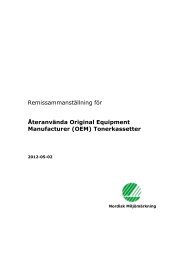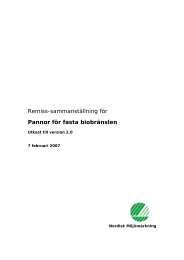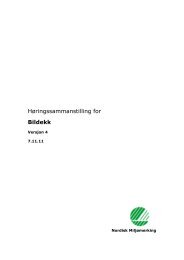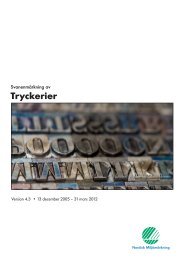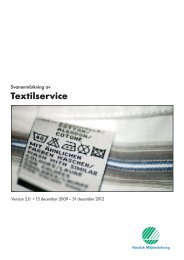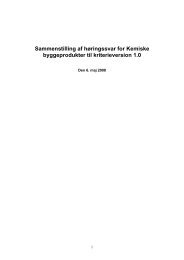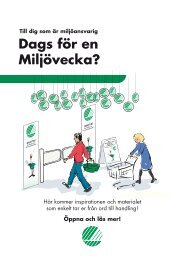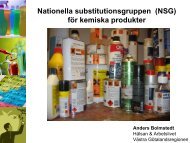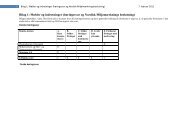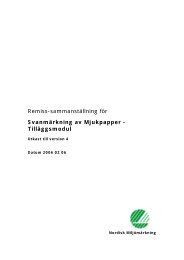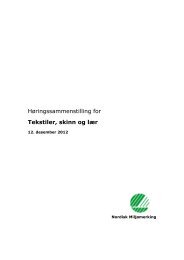Småhus, flerbostadshus och förskolebyggnader - Svanen
Småhus, flerbostadshus och förskolebyggnader - Svanen
Småhus, flerbostadshus och förskolebyggnader - Svanen
Create successful ePaper yourself
Turn your PDF publications into a flip-book with our unique Google optimized e-Paper software.
Nordisk Miljømerking<br />
Hus, leiligheter og barnehager 089/versjon 2<br />
Høringssammenstilling, oppdatert 10. august 2010<br />
Plastindustrien i Danmark<br />
Det nævnes i baggrundsdokumentet, at kravene til miljømærkede byggeprodukter<br />
vil udelukke næsten alle produkter, som er klassificeret som miljø- eller<br />
sundhedsskadelige. Derfor har man i miljømærkekriterierne tilladt produkter med<br />
visse klassifikationer. Det virker vilkårlig og ikke objektivt og fagligt underbygget at<br />
opstille kriterier ud fra en formodning om, at der så nok vil være nogle produkter,<br />
der kan opfylde kravene.<br />
Norima (norske mineralullprodusenter)<br />
Norima finner det hensiktsmessig, at det legges opp til anvendelse av klassifisering av<br />
stoffer i byggematerialer i henhold til internasjonale standarder (EU og GHS).<br />
Confederation of Finnish Construction Industries RT Finland<br />
The selection of banned products and substances in the Nordic Ecolabel is not based on<br />
scientific grounds and does not take account of European legislation. Chemical<br />
construction products are already covered by the Construction Products Directive (CPD);<br />
it will be replaced by the Construction Products Regulation (CPR) in the near future.<br />
Another leading legislation is the new European chemicals regulation, REACH. With<br />
REACH, the EU adopted the most stringent and comprehensive chemicals policy<br />
instrument in the world. With its entry into force, the chemical safety assessment<br />
procedure initiated by the ESR will become the rule for practically all substances<br />
including those used in construction products. REACH focuses on gathering existing<br />
data, filling potential data gaps, identifying potential hazards, determining exposure and<br />
evaluating potential risks through the scientific chemical safety assessment process.<br />
REACH clearly recognises that a risk is related to a use or an application. The safe use of<br />
a substance is documented via the exposure scenarios in the extended Safety Data Sheet<br />
which is passed down the supply chain. This risk-‐based approach throughout the<br />
substance life cycle is the common ground of the EU chemicals regulation.<br />
BING, Europe<br />
Material‐related indicators disregard existing legislation<br />
The selection of banned products and substances in the Nordic Ecolabel is not based on<br />
scientific grounds and does not take account of European legislation.<br />
Chemical construction products are already covered by the Construction Products<br />
Directive (CPD) which will be replaced by the Construction Products Regulation (CPR)4.<br />
Another important piece of legislation is the new European chemicals regulation,<br />
REACH5. With REACH, the EU adopted the most stringent and comprehensive<br />
chemicals policy instrument in the world. With its entry into force, the chemical safety<br />
assessment procedure initiated by the ESR6 will become the rule for practically all<br />
substances including those used in construction products.<br />
REACH focuses on gathering existing data, filling potential data gaps, identifying<br />
potential hazards, determining exposure and evaluating potential risks through the<br />
scientific chemical safety assessment process. REACH clearly recognises that a risk is<br />
related to a use or an application. The safe use of a substance is documented via the<br />
66 (165)



